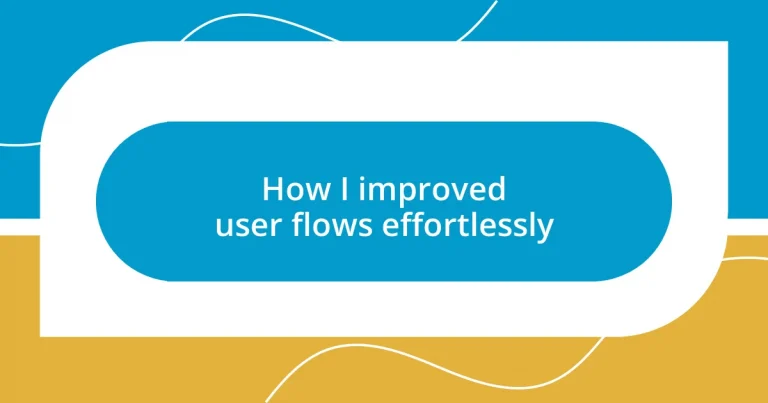Key takeaways:
- User flows are critical for enhancing digital experiences, as they guide users intuitively and empathetically through their journeys.
- Identifying user pain points via feedback, analytics, and testing can significantly improve user satisfaction and retention.
- Continuous iteration based on real user interactions and feedback fosters deeper connections and leads to a more refined user experience.
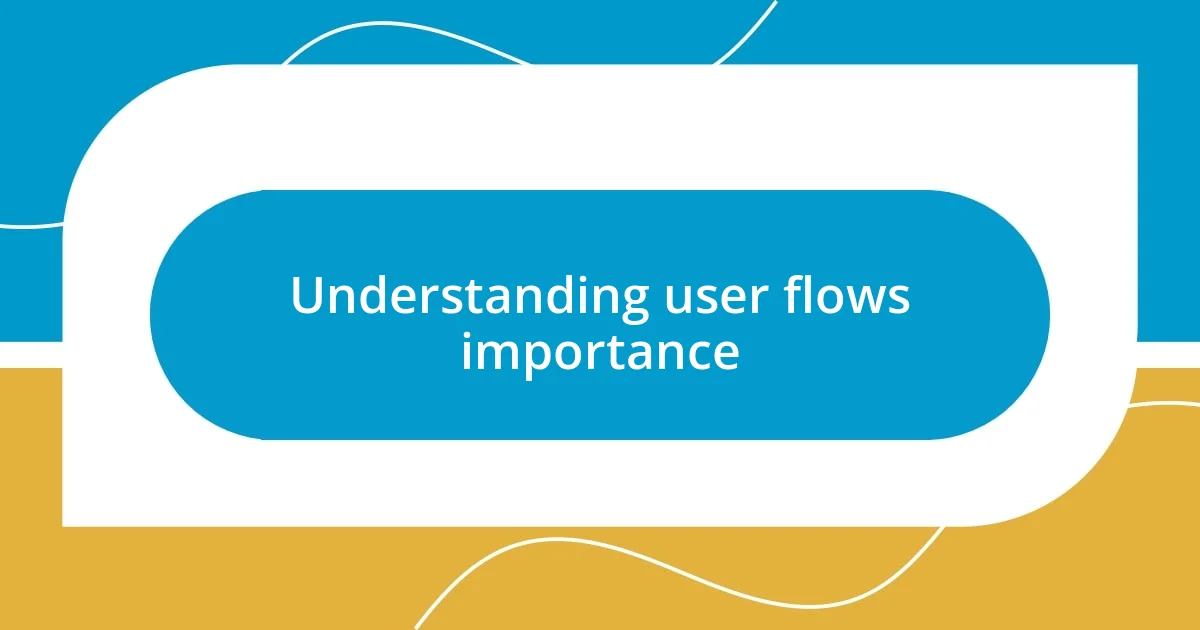
Understanding user flows importance
User flows are the backbone of any digital experience, guiding users through a seamless journey. I vividly remember when I first analyzed the flow of an e-commerce site I was working on—it was like peeling back layers of an onion. Each step revealed the potential frustrations a user could face if the journey wasn’t intuitive. Have you ever felt lost on a website, unsure of where to click next? That’s the feeling I wanted to avoid.
Understanding user flows means recognizing the emotional states users experience as they navigate. When I revamped a mobile app’s interface, I made it a priority to empathize with users’ emotions. I thought about how they might feel overwhelmed when they can’t find the right information. By simplifying their journey, I wasn’t just improving usability; I was enhancing their overall experience, making them feel valued and understood.
The importance of user flows hits home when you consider the consequences of neglecting them. Imagine investing countless hours into a project only for users to abandon it at the first hurdle. I’ll never forget the frustration I felt watching users drop off in a key step of a signup process. By paying close attention to user flows, I learned that even small adjustments can lead to significant increases in user retention and satisfaction. What about you? Have you ever noticed how a simple change can make all the difference?
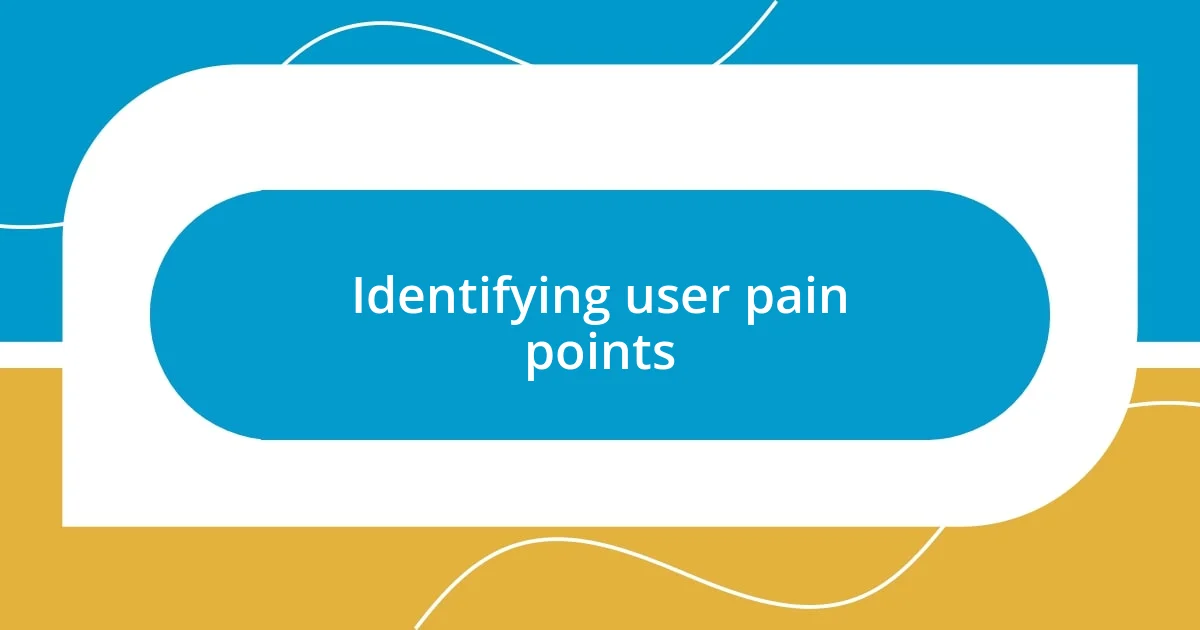
Identifying user pain points
Identifying user pain points is essential for crafting an effective user flow. I recall a time when I conducted usability testing on a financial app. Users struggled to complete their transactions due to confusing jargon and unclear navigation. It struck me how crucial it is to analyze each interaction for potential barriers.
To pinpoint user pain points, consider these strategies:
- User Feedback: Actively seek insights from users through surveys or interviews. The feedback can be an eye-opener.
- Analytics Review: Dive into user behavior analytics to recognize drop-off points. Numbers can tell you where the frustration lies.
- Session Recordings: Watching users interact with your product reveals real-time struggles that might not come up in feedback.
- A/B Testing: Implement changes based on hypotheses and compare results. This helps identify what genuinely improves user experience.
In my experience, repeatedly reviewing these aspects has made a noticeable impact. It often feels like detective work, but I’ve found that uncovering these pain points paves the way for a smoother user experience.
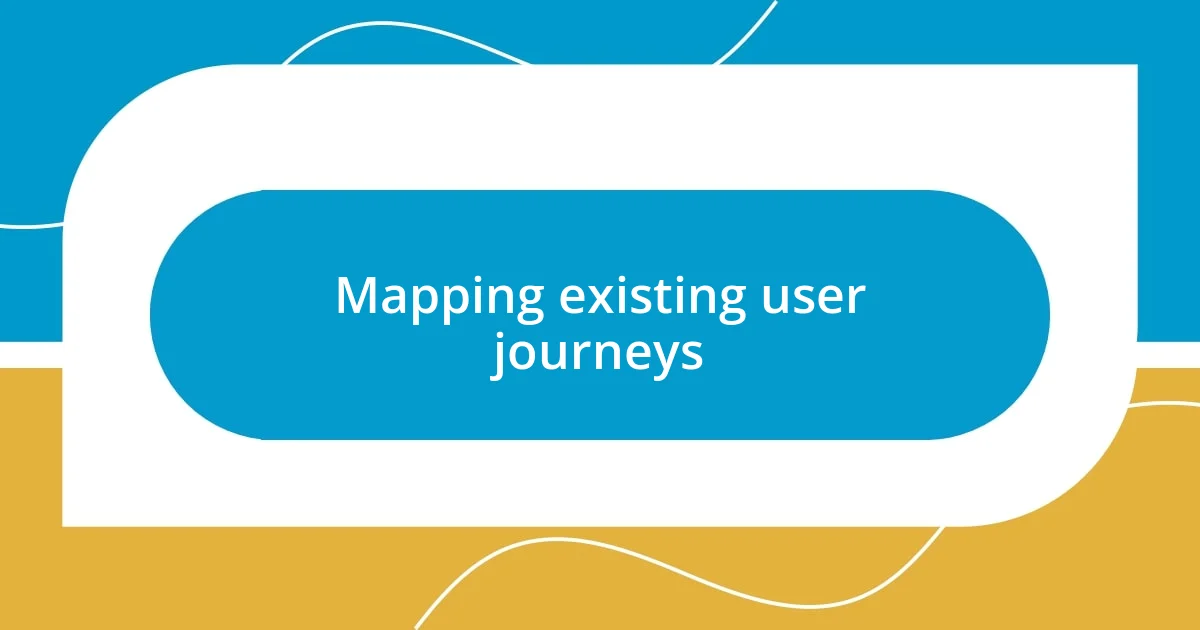
Mapping existing user journeys
Mapping existing user journeys is a crucial step in understanding how users navigate through your digital platform. One time, while mapping the user journey for a healthcare website, I felt like a detective piecing together a puzzle. It was fascinating to visualize each interaction, from the landing page to appointment scheduling. This exercise not only illuminated areas for improvement but also helped me empathize with the frustrations users faced during their journey.
When I compare different user journeys, I notice patterns that can make significant differences in user satisfaction. I once worked on a project where a lengthy checkout process discouraged users from completing their purchases. Mapping this journey revealed unnecessary steps that, once eliminated, transformed user engagement. The excitement of seeing conversion rates soar post-implementation was incredibly rewarding!
It’s essential to remember that mapping isn’t just about the steps; it’s about the emotions tied to each interaction. I often reflect on how users feel at each point, as small emotional cues can dramatically influence their next steps. For instance, after mapping a travel booking site, I observed that users became anxious during the payment phase. By simplifying this process and reassuring them, we not only improved their journey but also built trust.
| Aspect | Description |
|---|---|
| Purpose | To visualize user interactions and identify pain points |
| Emotional Insight | Understanding user emotions at each step enhances empathy |
| Outcome | Improved user satisfaction and engagement |
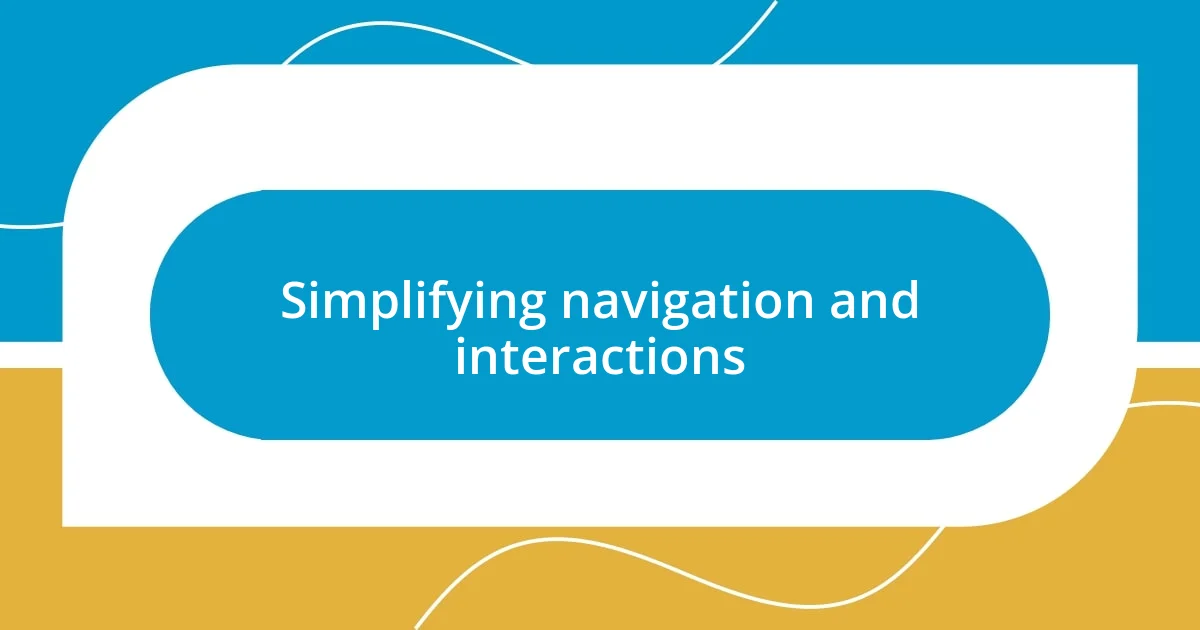
Simplifying navigation and interactions
Improving navigation really resonates with me, especially when I think back to simplifying a project management tool. Users often expressed frustration with navigating countless tabs. So, I decided to streamline the menu by consolidating similar features. The reaction was immediate—users felt less overwhelmed, which made me realize that less truly can be more.
In my experience, interactions must feel intuitive. During a redesign of an e-commerce site, I drew inspiration from user behavior; they often hesitated at the checkout step. By implementing a progress bar and clearer calls to action, users reported feeling more in control. How satisfying it was to hear that moment when they realized completing a purchase was just a few clicks away! It’s incredible what a little clarity can do.
I often wonder how much time and energy could be saved if we simply put ourselves in the user’s shoes. For instance, I remember navigating a new software platform and getting lost in the maze of options. By simplifying interactions and prioritizing essential features, I not only made it easier for users to find their way but also transformed their experience from a struggle into a seamless journey. Wouldn’t you agree that ease of navigation can elevate the entire user journey?
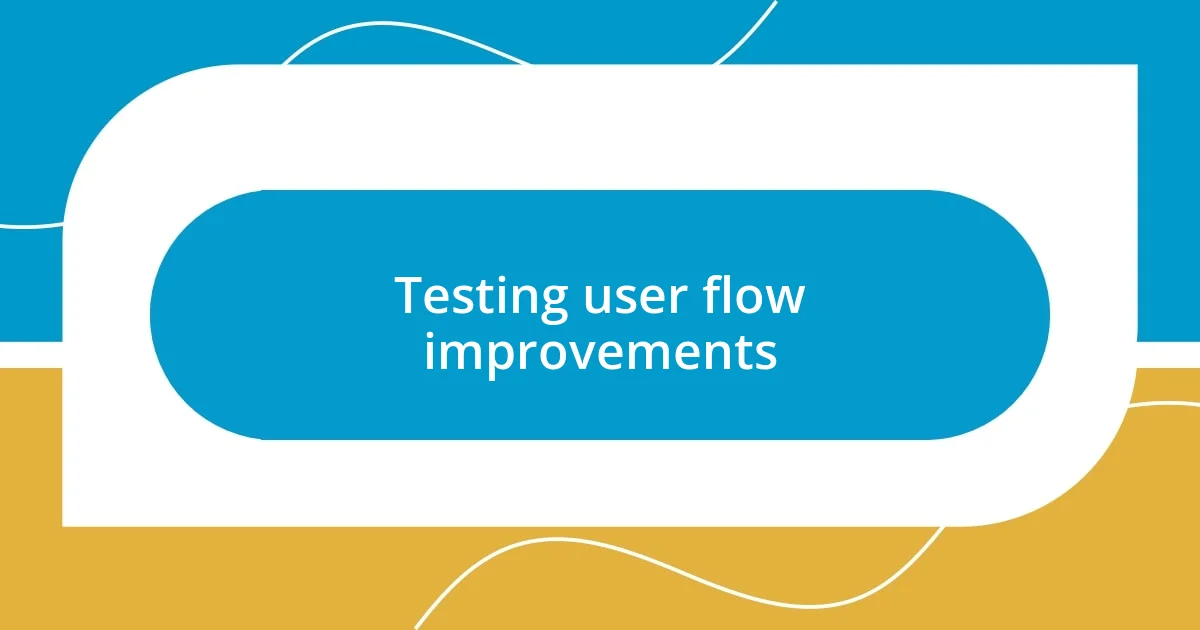
Testing user flow improvements
Testing user flow improvements is all about observation. I remember one project where we ran A/B tests to gauge the impact of our design changes. Watching users interact with the two different versions, I noted every pause, every click hesitation. It was eye-opening to see how even minor tweaks—like adjusting button colors or repositioning elements—could shift user behavior significantly. Have you ever considered how something as simple as a button’s placement can have such a profound impact?
I find that user feedback during testing is an invaluable goldmine. Once, after implementing a revised onboarding process for a mobile app, I set up a session where potential users could share their thoughts in real-time. Their candid responses provided insights into how I could further refine the flow. It’s in those moments of genuine user interaction that you realize testing isn’t just about numbers; it’s about understanding real human experiences and emotions.
Moreover, tracking metrics such as completion rates can tell you a lot about your improvements. I distinctly recall analyzing user data for a content platform where we made enhancements to the content discovery flow. The spike in engagement after those changes felt gratifying! Reflecting on that experience, I learned that continuous testing and iteration are crucial. The journey to improve user flows isn’t a one-off task; it’s a dynamic process that requires us to remain vigilant and responsive to user needs. Isn’t that what keeps the design process exciting?
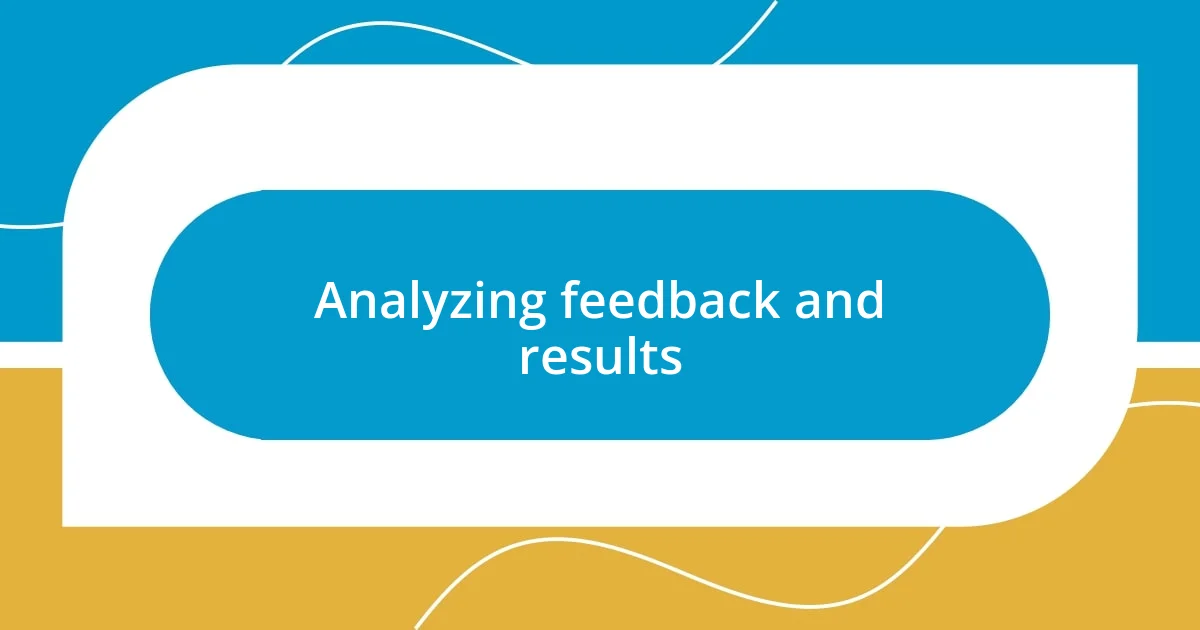
Analyzing feedback and results
Analyzing feedback and results is where the magic truly happens. I recall a project where we gathered direct feedback through surveys after implementing changes. Seeing users articulate their feelings—some were thrilled, while others were puzzled—helped me grasp the nuances of their journey. It made me realize that each piece of feedback is like a treasure map, guiding us toward areas that need refinement.
Delving into analytics provides a wealth of insights too. For instance, after launching an updated dashboard for a data visualization tool, I noticed a distinct drop in bounce rates. This wasn’t just numbers; it signified that users found value in the new layout. I couldn’t help but feel a surge of pride knowing that our efforts resonated with users. Have you ever felt that rush when data validates your hard work?
I often find it crucial to revisit the feedback loop. One time, we created a feedback channel specifically for post-launch reactions. Engaging with users in this ongoing dialogue not only informed further improvements but also fostered a sense of community. Their stories, shared so openly, often provided the emotional backbone for our next iterations. Isn’t it amazing how listening and adapting can lead to a deeper connection with users?
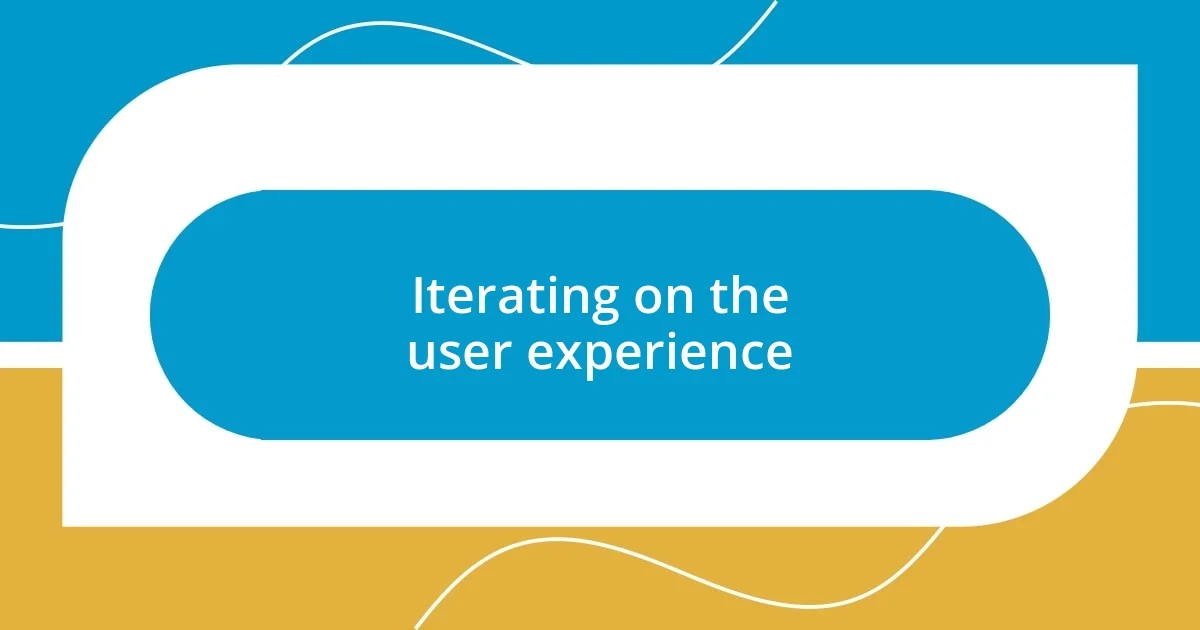
Iterating on the user experience
Iterating on user experience is truly a transformative process. I remember once collaborating on an e-commerce site where we continuously refined the checkout experience. During each iteration, we would host focus groups, watching users navigate the process. It was enlightening to hear their candid thoughts sprinkled with their laughter or frustrations—it turned our analytical data into real emotional narratives. Have you ever witnessed how real people interact with your designs? It’s an experience that sticks with you.
One pivotal moment for me was when we decided to implement a card sorting technique to reorganize product categories. Initially, I thought our categories were straightforward, but the insights revealed overlapping themes that users found confusing. Watching users empathize with one another as they discussed their preferences was a proud moment for me; it showed the power of collaboration in shaping experiences. Moments like this remind me that iteration isn’t just about making changes; it’s about fostering deeper connections and understanding with our audience.
Reflecting on a project where we launched a new feature, I remember how it felt to receive immediate feedback. Users were quick to express their delight, but they were equally vocal about what didn’t work. It was almost like a rollercoaster of emotions, where each piece of feedback felt like a twist in the ride! Embracing these ups and downs really underlined for me the importance of being adaptable. How many times have we all found ourselves unexpectedly veering off our original course, only to discover new paths that lead to richer user experiences?












